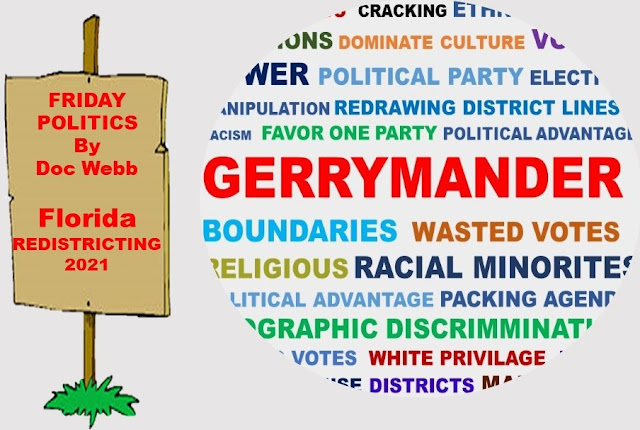 |
WEST COAST
Opinion by:
E. Eugene Webb PhD
Author:
In
Search of Robin
It's that time of the year again following the census when states are faced with the requirements for redistricting.
Redistricting
is the process of drawing political boundaries for electoral and political
districts in the United States and in Florida, in particular, and is usually
done every 10 years following the census.
The US
constitution requires that each representative in the US Congress represent an
equal number of citizens and mandates a census to determine the number of
citizens and apportion the seats to the state.
Since
redistricting, is in the hands of the Florida State Legislature which is
predominantly Republican in political stance, there are always confusion and
angst in both political parties, Republican and Democrat regarding the
redistricting process.
The
most common political battles surrounding redistricting involves something
called gerrymandering.
Gerrymandering BALLOTOPEDIA
The
term gerrymandering refers to the practice of drawing electoral district lines
to favor one political party, individual, or constituency over another. When
used in a rhetorical manner by opponents of a particular district map, the term
has a negative connotation but does not necessarily address the legality of a
challenged map. In this context, proponents may counter that the map has not
been gerrymandered but has been drawn to conform with overlapping, potentially
conflicting redistricting standards. The term can also be used in legal
proceedings and documents; in this context, the term describes redistricting
practices that violate federal or state laws.
From Common
Cause by: Ellen Freidlin, of Fair Districts Florida; A Guide to the 2022 Redistricting process in Florida:
Criteria for State Legislative and Congressional Districts
“The
FairDistricts Amendments (passed in 2010) established constitutional
requirements for the Legislature to follow when drawing state legislative and
Congressional districts. If the rules are not followed, there are grounds for a
legal challenge.
Tier 1 criteria:
No
apportionment plan or district shall be drawn with the intent to favor or
disfavor a political party or an incumbent – no partisan gerrymandering; and
Districts
shall not be drawn with the intent or result of denying or abridging the equal
opportunity of racial or language minorities to participate in the political
process or to diminish their ability to elect representatives of their choice –
no racial gerrymandering.
Tier 2 criteria (must be followed unless doing so would conflict with the Tier
one standards or federal law):
Districts
shall consist of contiguous territory;
Districts
shall be as nearly equal in population as is practicable;
Districts
shall be compact; and
District
lines shall, where feasible, follow existing political and geographical
boundaries.”
Criteria-Driven
Legislative Redistricting with Judicial Approval: (FairVote)
“Based
on the approach taken in Florida, this reform would continue to allow the state
legislature to adopt district maps, but it would require it to do so according
to criteria set by statute. At the end of the process, the maps would have to
be approved by the state Supreme Court as complying with the criteria.”
As
citizens of Florida, we are merely observers in the redistricting process here
in Florida, which ofttimes appears to be more of a cross between a circus
sideshow and an opera.
Rarely
do members of the Florida House or Senate request or even want, for that
matter, public input on redistricting issues. This is a political process
reserved for the politicians and the political insiders who want to gain the
greatest political advantage in their counties and in the state legislature.
It's a
good idea to follow these proceedings. We all hear a lot about it on the news
both electronic and print and off times if there are significantly egregious changes
proposed you may even see some legal action.
The
greatest impact may be new opportunities for additional members of the state house
in districts that have experienced significant population growth over the last
ten years. Once redistricting is complete, in the next election cycle, we'll
have all these potential new political opportunities on the ballot.
That's
the time you want to start paying attention.
See
Doc's Photo Gallery at Bay Post Photos.
Disclosures:
No comments:
Post a Comment